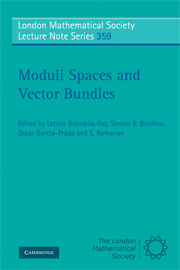Book contents
- Frontmatter
- Contents
- Preface
- Acknowledgments
- Part I Lecture Notes
- Part II Survey Articles
- Part III Research Articles
- 13 Beilinson Type Spectral Sequences on Scrolls
- 14 Coherent Systems on a Nodal Curve
- 15 Brill-Noether Bundles and Coherent Systems on Special Curves
- 16 Higgs Bundles in the Vector Representation
16 - Higgs Bundles in the Vector Representation
Published online by Cambridge University Press: 07 September 2011
- Frontmatter
- Contents
- Preface
- Acknowledgments
- Part I Lecture Notes
- Part II Survey Articles
- Part III Research Articles
- 13 Beilinson Type Spectral Sequences on Scrolls
- 14 Coherent Systems on a Nodal Curve
- 15 Brill-Noether Bundles and Coherent Systems on Special Curves
- 16 Higgs Bundles in the Vector Representation
Summary
Dedicated to Peter Newstead on the occasion of his 65th birthday.
Introduction
A Higgs bundle, as introduced by the author 20 years ago [H1], consists of a holomorphic bundle E over a compact Riemann surface ∑ together with a section Φ ∈ H0 (∑, End E ⊗ K) (called the Higgs field) satisfying a certain stability condition. This can be generalized to a holomorphic principal G-bundle P over ∑ together with a section Φ of the bundle Ad(P) ⊗ K. The moduli space of such pairs has a very rich geometry and featured recently in the physical derivation by A.Kapustin and E.Witten of the central ideas of the geometric Langlands programme [KW]. A further paper by Kapustin [K] initiates a parallel discussion where the Higgs field Φ takes values in R(P) ⊗ K for a representation more general than the adjoint. In particular, he considers the case where G = SU(n) and R consists of k copies of the n-dimensional vector representation. This means that we have a rank n vector bundle E with trivial determinant and Φ = (ϕ1, …, ϕk) ∈ H0 (∑, E ⊗ K) ⊗ Ck.
The study of the algebraic geometry of these moduli spaces already exists in the literature under the name of stable k-pairs [BDGW], [BDW]. These papers, however, generally differ from the current problem in two ways. One is the type of moduli space considered.
- Type
- Chapter
- Information
- Moduli Spaces and Vector Bundles , pp. 473 - 483Publisher: Cambridge University PressPrint publication year: 2009

